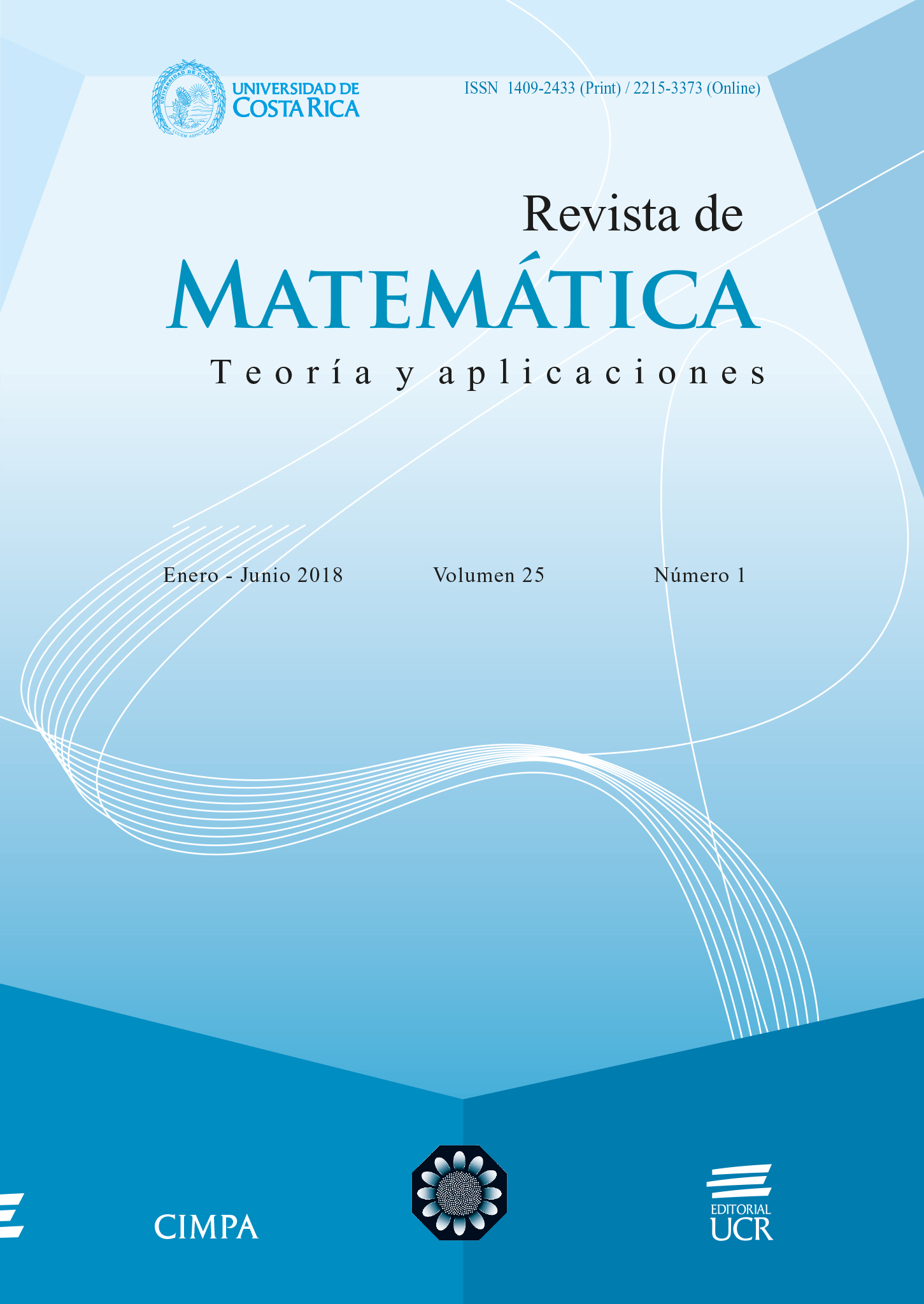Resumen
Estudiamos un vector de tres entradas, que llamaremos “espíritu bursátil”, que refleja el sentimiento sobre si un índice de una Bolsa de Valores va a subir, bajar o permanecer igual. Siguiendo el trabajo sobre la “mentalidad”, expuesto en Ulate(2006), dicho sentimiento será visto como un ser vivo, que es una manifestación de una Cultura o Mentalidad en un momento dado. Veremos el cambio de este sentimiento de la misma forma que se ve en animales o plantas. Utilizamos sistemas de ecuaciones diferenciales para describir el cambio y réplica en el tiempo de dicho espíritu, siguiendo la Teoría de Juegos Evolutivos. El sistema de tres ecuaciones será comparado con el sistema de dos ecuaciones, conocido como Lotka Volterra.
Citas
Acuña, O.; Ulate, F. (1992) “Equilibrio de Precios y Óptimo de Pareto en Intercambio”, Revista de Matemática: Teoría y Aplicaciones 3(1):
Acuña, O.; Ulate, F. (2008) “Adam Smith y Sistemas Dinámicos”, Revista de Ciencias Económicas 26(1): 171–185.
Alloy, L.; Abrahamson, L. (1988) “Depressive Realism”, in: L.B. Alloy (Ed.) Cognitive Processes in Depression, Guilford Press, New York: 441– 485.
Bomze, I.M. (1983) “Lotka–Volterra Equations and Replicator Dynamics: A Two Dimensional Classification”, Biological Cybernetics. 48: 201–211.
Farkas, M. (1994) Periodic Motions. Springer Verlag, New York.
Feldman, M.; Cavalli–Sforza, L. (1976) “Cultural and Biological Evolutionary Processes, Selection for a Trait Under Complex Transmission”, Theoretical Population Biology 9:238–259
Hegel, J. (1928) “Filosofía de la historia universal”, Rev. Occidente. Madrid.
Hegel, J. (1966) Fenomenología del Espíritu. Fondo de Cultura Económica, México D.F.
Hofbauer, J. (1981) “On the Ocurrence of Limit Cycles in the Volterra–Lotka Equation”, Nonlinear Analysis, Methods & Applications 5(9): 1003–1007.
Hofbauer, J.; Schuster, P.; Sigmund, K. (1979) “A Note On Evolutionary Stable Strategies and Game Dynamics”, Journal Theoretical Biology 81: 609–612.
Hofbauer, J.; Sigmund, K. (1998) Evolutionary Games and Population Dynamics. Cambridge University Press, Cambridge.
InvestingAnswers (2016) “Bull/Bear Ratio”, en: http://www.investinganswers.com/financial-dictionary/stock-market/bullbear-ratio-1775.
Lotka, A. (1956) Elements of Mathematical Biology. Dover Publications, New York.
Maynard, J. (1982) Evolution and the Theory of Games. Cambridge University Press, Cambridge.
Maynard, J.; Price, G. (1973) “The Logic of Animal Conflict”, Nature 246: 15–18.
Murphy, C. (2016) “What is the put-call ratio and why should I pay attention to it?”, en: https://www.investopedia.com/ask/answers/06/putcallratio.asp
Ro, S. (2016) “UBS: The stock market guides the FED”, Yahoo Finance, May 9, 2016. Tomado de finance.yahoo.com/news/ubs-equities-stocks-guide-fed-dots-monetary-policy-201427082.html
Schumpeter, J. (1996) Capitalismo, Socialismo y Democracia. Folio, Barcelona.
Stock Charts (2016) http://stockcharts.com/school/doku.php?id=chart--school:technical--indicators:put--call--ratio
Taylor, P.; Jonker, L. (1978) “Evolutionary Stable Strategies and Game Dynamics”, Mathematical Biosciences 40(1 y 2): 145–156.
Thomas, W. (1923) The Unadjusted Girl: With Cases and Standpoint for Behavior Analysis. Little, Brown and Company, Boston.
TradingSim (s.f) “Bull Bear Ratio Definition and Formula”, en: https://tradingsim.com/blog/bull-bear-ratio/.
Ulate, F. (1988) “El Modelo Neoclásico y una Política de Crecimiento para Costa Rica”, Revista de Ciencias Económicas 8(1): 39–53.
Ulate, F. (2006) “Formalización de una Teoría de la Mentalidad”, Revista de Matemática: Teoría y Aplicaciones 13(1): 53–80
Volterra, V. (1931) Leçons sur la Théorie Mathématique de la Lutte pour la Vie. Gauthier–Villars, Paris.
Weibull, J. (1995) Evolutionary Game Theory. MIT Press, Cambridge.
Yardeni, E.; Abbott, J.; Johnson, D.; Quintana, M. (2017) “Stock Market Indicators: Bull/Bear Ratios”, en: http://www.yardeni.com/pub/stmktbullbear.pdf.
Zeeman, E. (1981) “Dynamics of the Evolution of Animal Conflicts”, Journal of Theoretical Biology 89(2): 249–270.





